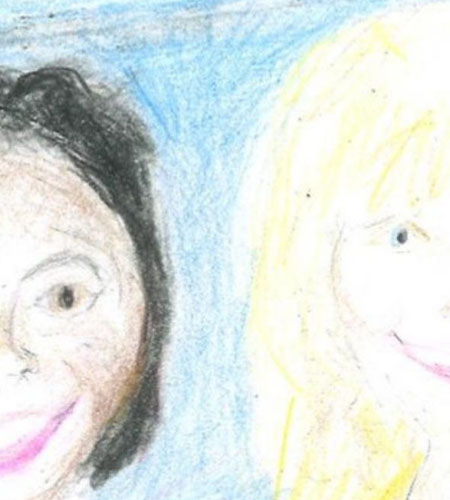Issue Archive
My daughter was murdered: “There are no words”

Deborah A. Stiles
There are no words.
I am a white woman who is a professor and psychologist; I suffered a traumatic loss in 2022 when my 34-year-old African American foster daughter was murdered. Although we were not biologically related, I was her mother, and she was my daughter; I deeply cherished and depended upon our relationship. To quote the message from a fellow foster parent and dear friend, “She was your daughter—born of your heart.”
Here I am writing about my personal perspective. I am not writing about everything that happened; I am writing about what has been most important for me as I have been transformed by the loss of my beloved daughter. Because I am a professor, I am also connecting my personal experiences with professional literature.
I would describe myself as a mild-mannered professor and peace psychologist. When my daughter was killed, I was in Europe and presenting at an international psychology conference. I did not learn about my daughter’s death until l returned to the United States. According to the newspapers, it was a brutal murder; she was shot to death. Learning about her violent death was shocking and scary for me. Violent crimes are associated with extreme distress for victims (Norris & Kaniasty, 1994). A friend who is a private investigator told me that due to the intentional killing of my daughter, she had concerns about my personal safety. Later, I read that concerns about physical safety are not uncommon for family members when there has been a murder; observations of the grief of parents of murdered children have found that the parents are often fearful about their own safety (Peach & Klass, 1987).
These frightening circumstances shook me to my core, and I resolved to continue to read everything I could so I might understand what had happened. For instance, I found out that “Homicide is a leading cause of death for young adults and typically leaves in its wake survivors who struggle to face life following this traumatic form of loss. The demography of death is not democratic, as some cultural groups are far more likely to experience traumatic bereavement than others… a disproportionate number of murder victims in the United States are African American” (McDevitt-Murphy, et al., 2012, p. 2011). Later, I read an article, “Development and Validation of the Inventory of Stress and Coping for African American Survivors of Homicide Victims” (Sharpe et al., 2022). The subscales in the Inventory of Stress and Coping for African American Survivors of Homicide Victims (ISCASHV) measure were Cultural Trauma, Reactions to Homicide, Culture of Homicide, Racial Appraisal, and Coping (p. 6). The article included the coping strategies that Black homicide survivors use. I discovered that I followed two of the most common coping strategies of Black homicide survivors: “spiritual coping and meaning making” and “maintaining a connection to the deceased.”
My house is still filled with photos of my daughter, and I think about her every day. Because I was very afraid of some members of my daughter’s family, I was not part of the “collective caring” described by Sharpe et al. (2022).
My grief about my daughter’s death has been profound and complicated for many reasons. I was a foster parent, and I met my daughter when she was 14-years-old. She had a terrible and violent childhood; she told me she did not want to be adopted by me because she felt she had been her own parent from a very young age. And so, when she was 16-years-old, I helped her become legally emancipated and a “mother to herself.” Even so, she always called me Mom, and we remained close until her death.
I am five feet, five inches tall with straight blond hair and my daughter was only five feet tall; she had black hair in a new hairstyle almost every day. Despite the obvious differences in our appearance, most strangers we met knew that we were mother and daughter. My daughter and I had the same cheekbones, smile, and interests. We both loved learning, art, creative writing, poetry, fashion, wearing high heels, and dancing. After her death, I attended a webinar titled “Transformed by Loss” and later made a sketch of us (see Author Image 1).
Through reading books and articles, I learned that the death of a child from homicide creates a “particularly difficult form of bereavement and one that involves multiple losses of both an actual and symbolic nature” (Rinear, 1987, p. 315). As for me, I lost my family, my identity as a mother, my identity as a member of an interracial family, my holiday plans, my happiness, my well-being, etc. I also read that, “The grief of parents who have lost children to murder is extreme, prolonged, and unique” (Kashka & Beard, 1999, p. 22). This previous quote is from an article written by two professors of nursing, both of whom had lost children to homicide. I learned from their article that [survivors of homicide] “feel stigmatized and isolated from others in their social network” (p. 27). Their observation matches my own experience; I eventually realized that the word “murder” is a conversation stopper. When people asked me how my daughter died and I answered, “She was murdered,” our conversation would be over.
I also discovered that it was rarely helpful for me to talk with people who had not known my daughter. Three exceptions were the conversations I had with the pastor of my church, a friend who is a licensed professional counselor, and a session with a dance movement therapist (DMT).
When I did speak with my friends who had known my daughter, the most common response was “There are no words.” My friends were right about words being inadequate. The murder of my daughter disrupted my sense of self and dysregulated my body sensations and movement. I knew in my heart of hearts that “talk therapy” was not what I needed. I read that “trauma affects somatic functioning, nervous system regulation, relational engagement, and personality integration” (Dent, 2020, p. 435).
As I continued to read, I became intrigued by an article titled, “Thriving after trauma: The experience of parents of murdered children”; this article described sixteen parents of murdered children who experienced posttraumatic growth (Parappully et al., 2002). Based on questionnaires and interviews from the sixteen parents of murdered children, the article describes these parents’ journeys from profound traumatization to personal transformation related to thinking, feeling, and behavior. The bereaved parents described finding meaning in the tragedy and making a personal decision “to rise up phoenix-like from the ashes” (Parappully et al., 2002, p. 46). I identified with the sixteen participants’ determination, compassion, spirituality, and desire to maintain a continuing affective bond with their deceased children. Early on, I made a promise to myself to live in a way that would honor my daughter’s memory.
Although I am inspired by the sixteen parents who experienced posttraumatic growth, I know myself and I know my continuing journey towards thriving will be different from their journeys. Because “there are no words,” I am exploring healing without words through running and art therapy. There is no strong “evidence-base” for the benefits of using running and art therapy as grief interventions (Asgari et al., 2022). However, both silent pursuits are working well for me. I run almost every day; and when I run, I am moving forward and not stuck in grief. For me, running is not a chore, but a source of happiness and the sweet joy of movement. The physiological benefits of running may include leading to the growth of new nerve cells and blood vessels as well as improving brain functioning and heart health. Running also helps me think of my daughter and the times we enjoyed running together.
For me, drawing is a way of accessing my innermost self. In this pencil drawing (see Author Image 2) of a photograph taken almost seventeen years ago, I am giving my daughter away as I walk her down the “aisle” for her wedding in my backyard. I think I chose to make this drawing of me giving her away because I am releasing her to whatever might be beyond life. She no longer lives on the earth, but I can, and I do honor her memory.
